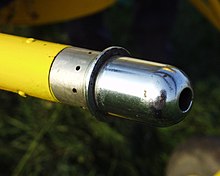Pitot tube





A pitot tube (/ˈpiːtoʊ/ PEE-toh; also pitot probe) measures fluid flow velocity. It was invented by a French engineer, Henri Pitot, in the early 18th century,[1] and was modified to its modern form in the mid-19th century by a French scientist, Henry Darcy.[2] It is widely used to determine the airspeed of aircraft;[3] the water speed of boats; and the flow velocity of liquids, air, and gases in industry.
Theory of operation
The basic pitot tube consists of a tube pointing directly into the fluid flow. As this tube contains fluid, a pressure can be measured; the moving fluid is brought to rest (stagnates) as there is no outlet to allow flow to continue. This pressure is the stagnation pressure of the fluid, also known as the total pressure or (particularly in aviation) the pitot pressure.
The measured stagnation pressure cannot itself be used to determine the fluid flow velocity (airspeed in aviation). However,
- Stagnation pressure = static pressure + dynamic pressure
Which can also be written
Solving that for flow velocity gives
where
- is the flow velocity;
- is the stagnation or total pressure;
- is the static pressure;
- and is the fluid density.
NOTE: The above equation applies only to fluids that can be treated as incompressible. Liquids are treated as incompressible under almost all conditions. Gases under certain conditions can be approximated as incompressible. See Compressibility.
The dynamic pressure, then, is the difference between the stagnation pressure and the static pressure. The dynamic pressure is then determined using a diaphragm inside an enclosed container. If the air on one side of the diaphragm is at the static pressure, and the other at the stagnation pressure, then the deflection of the diaphragm is proportional to the dynamic pressure.
In aircraft, the static pressure is generally measured using the
Instead of separate pitot and static ports, a pitot-static tube (also called a
If a liquid column
where
- is the height difference of the columns;
- is the density of the liquid in the manometer;
- g is the standard acceleration due to gravity.
Therefore,
Aircraft and accidents
A pitot-static system is a
Several commercial airline incidents and accidents have been traced to a failure of the pitot-static system. Examples include
Aeroperú Flight 603 had a fatal pitot-static system failure due to the cleaning crew leaving the static port blocked with tape.
Industry applications

In industry, the flow velocities being measured are often those flowing in ducts and tubing where measurements by an
The fluid flow rate in a duct can then be estimated from:
- Volume flow rate (cubic feet per minute) = duct area (square feet) × flow velocity (feet per minute)
- Volume flow rate (cubic meters per second) = duct area (square meters) × flow velocity (meters per second)
In aviation, airspeed is typically measured in knots.
In weather stations with high wind speeds, the pitot tube is modified to create a special type of anemometer called
See also
References
Notes
- ^ Pitot, Henri (1732). "Description d'une machine pour mesurer la vitesse des eaux courantes et le sillage des vaisseaux" (PDF). Histoire de l'Académie Royale des Sciences avec les mémoires de mathématique et de physique tirés des registres de cette Académie: 363–376. Retrieved 2009-06-19.
- ^ Darcy, Henry (1858). "Note relative à quelques modifications à introduire dans le tube de Pitot" (PDF). Annales des Ponts et Chaussées: 351–359. Retrieved 2009-07-31.
- ^ Venturi effect and Pitot tubes | Fluids | Physics | Khan Academy, retrieved 2019-12-15
- ^ "How Aircraft Instruments Work." Popular Science, March 1944, pp. 116.
- ISBN 0-88487-333-1.
- ^ "NASA Dryden news releases. (1995)".
- ^ "Training flaws exposed in Rio-Paris crash report". Reuters. 5 July 2012. Retrieved 5 October 2012.
- ^ Daly, Kieran (11 June 2009). "Air Caraibes Atlantique memo details pitot icing incidents". Flight International. Retrieved 19 February 2012.
- ^ "Instrumentation: Pitot Tube Static Anemometer, Part 1". Mount Washington Observatory. Archived from the original on 14 July 2014. Retrieved 14 July 2014.
Bibliography
- Kermode, A.C. (1996) [1972]. Mechanics of Flight. Barnard, R.H. (Ed.) and Philpott, D.R. (Ed.) (10th ed.). Prentice Hall. pp. 63–67. ISBN 0-582-23740-8.
- Pratt, Jeremy M. (2005) [1997]. The Private Pilot's Licence Course: Principles of Flight, Aircraft General Knowledge, Flight Performance and Planning (3rd ed.). gen108–gen111. ISBN 1-874783-23-3.
- Tietjens, O.G. (1934). Applied Hydro- and Aeromechanics, based on lectures of L. Prandtl, Ph.D. Dove Publications, Inc. pp. 226–239. ISBN 0-486-60375-X.
- Saleh, J.M. (2002). Fluid Flow Handbook. McGraw-Hill Professional.











